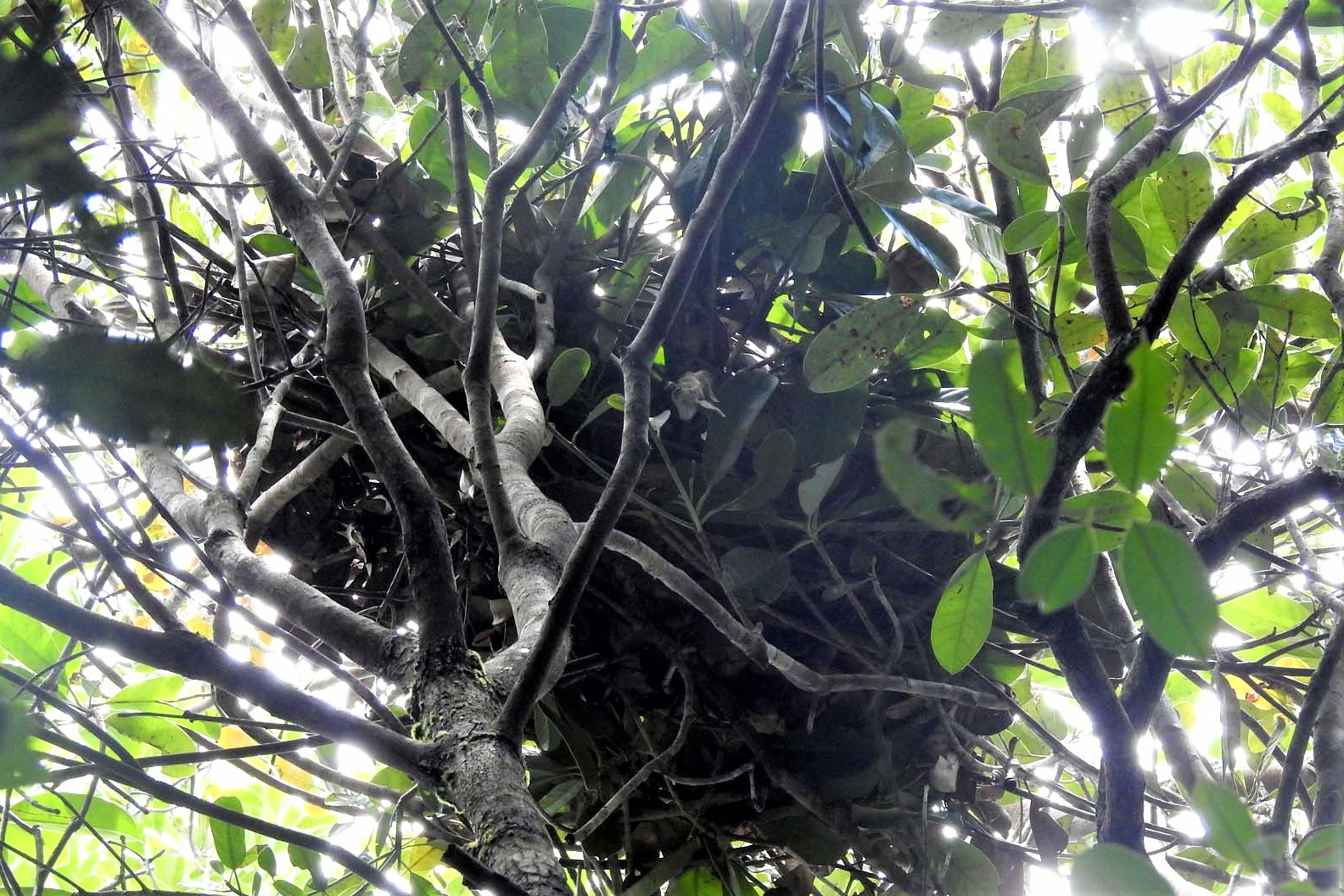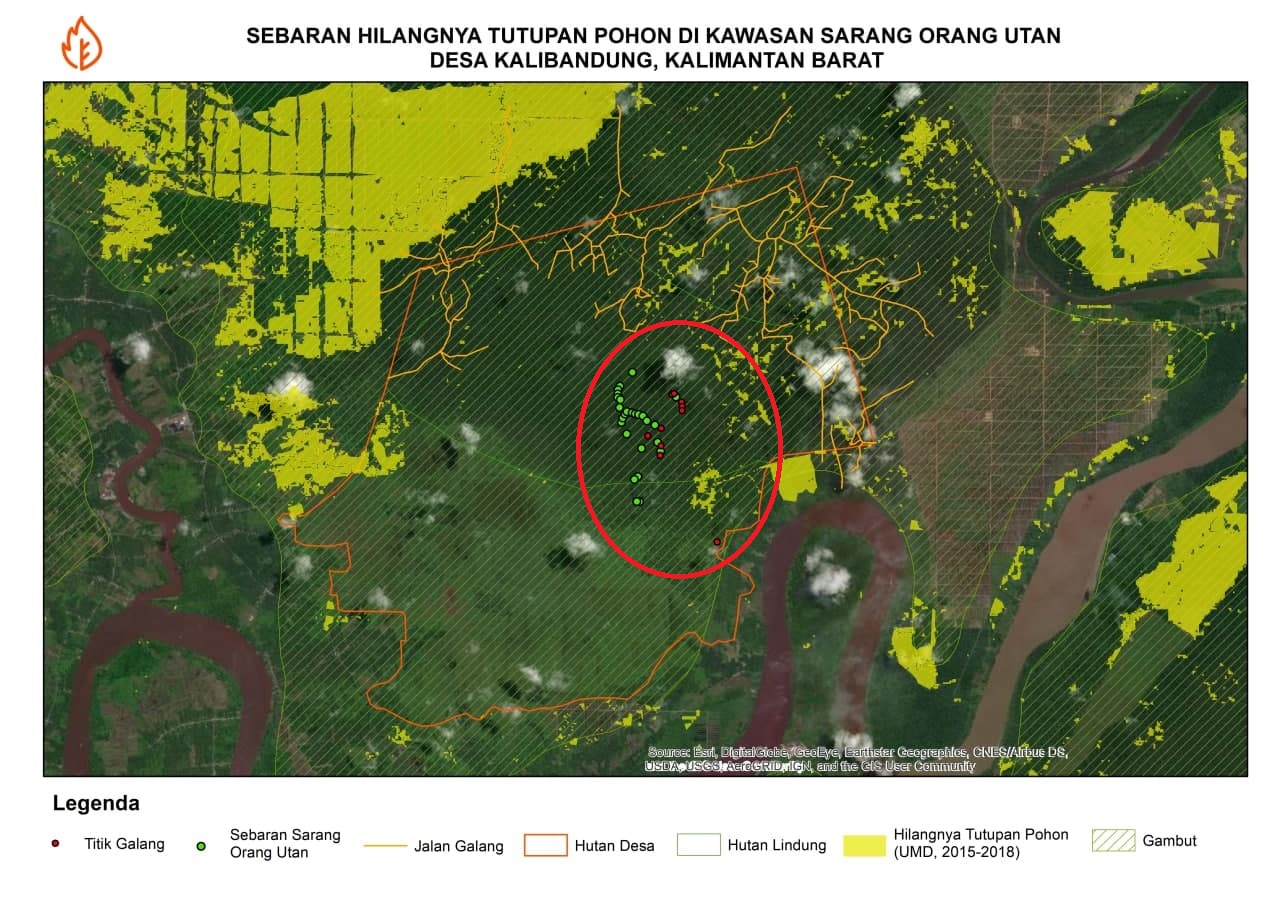Ministry of the Environment and Foresty Climate Change Event Photo Gallery
By Pantau GambutLast Traces of Orangutan in the Kalibandung Peat Forest
The speedboat docked in Inggris Bay, Kalibandung. Usman, a villager and the Head of the Kalibandung Village Forest Management Institution (LPHD), moored our boat onto the side of the waters. After the boat engine had been turned off, we could immediately hear the Bulbuls chirping as if to welcome us. Bulbuls are part of the songbird species. These small birds are often bred and brought to songbird competitions due to their distinctive sound.
We then headed to Kalibandung Village Forest, which is approximately 7,000 hectares and located on peatland. The area consists of approximately 4,000 hectares of Convertible Production Forest (HPK) and approximately 3,000 hectares of Protected Forest.
We saw a multitude of biodiversity along the way, such as lempilik, kempas, jelutung, bintangor, gerunggang, ramin, meranti, and nepenthes. Usman stopped shortly and explained the benefit of medang for the Kalibandung villagers, they can use the wood as a building material and the leaves as medicine to relieve stomach ulcers.
This diversity of flora also supports the fauna in Kalibandung, which includes the orangutan.
At the end of July 2020, a survey conducted by LPHD Kalibandung and a team from the Kubu Raya Forest Management Unit (KPH) and Jari Indonesia West Borneo found 37 orangutan nests and trees that are a source of food for these primates.
The orangutan nest has served as the main reference for experts and conservation activists in tracing the orangutan population and habitat. The discovery of new nests is a strong indication that orangutans are still living in this fire-prone area.
“Some of the nests are large and some are small. Some of them are new nests. The leaves still look green, fresh, and smell like orangutan’s urine," said Usman.
The nests were found in the malam, bintangor, pacat-pacat, kempilik, mengkaang, rengas, medang, mentibak, fig, jungkang, and mentapis trees with a distance of 30-50 meters between the nests that are located in a relatively wide area in the protected forest.
Remaining population
The orangutans in Kalibandung are from the Pongo pygmaeus pygmaeus subspecies. This subspecies is the most endangered of the two Kalimantan orangutan subspecies in West Kalimantan. Their current population is estimated to comprise less than 1,500 orangutans. Forest encroachment and conversion are the biggest threats to the survival of the Pongo pygmaeus pygmaeus.
The existence of orangutans in Kalibandung was first published through the 2016 Orangutan Population and Habitat Viability Assessment (PHVA), which was prepared and published by the Ministry of Environment and Forestry (MoEF).
The report also mentions that there are only 10 orangutans remaining in the southern part of West Kalimantan, a significant decline from the 1,000 orangutans approximately a century ago. This means that the orangutan population is declining by an average of 10 orangutans per year.
“The orangutans in the southern zone are isolated due to land clearing activities. The Kalibandung Village Forest Area should be connected to Sungaiambawang (Sub-District). A small number of orangutans and habitats were also found in that area," said Tito Indrawan, Head of the West Kalimantan Orangutan Conservation Forum (Fokkab), when contacted last month.
According to Tito, Kalibandung Village Forest is one of the strategic and tactical efforts in rescuing the orangutan population and other biological resources. The Village Forest Scheme can increase community engagement in strengthening and providing effective supervision. The community has participated in patrolling activities and restoration activities conducted in the Kalibandung Village Forest.
"There are large oil palm plantation concessions surrounding the area. I recommend building a corridor between the forest areas to connect them. Moreover, each concession holder shall be required to reserve 10% of their area as a conservation area,” explained Tito.
The Head of KPH Kubu Raya, M Ari Susandi, agrees that the orangutan population and habitat along with the biodiversity in Kalibandung must be preserved. For this reason, they assigned a staff member in the survey on the potential of the Kalibandung Village Forest.
“We want to get in-depth information from the field. We will also publish the results, including the development of the corridor to the Natural Resources Conservation Center (BKSDA) and the Kubu Raya District Government,” said Ari in a separate interview last month.
Forest and land fires and logging activities
Approximately 4,000 hectares of the Kalibandung Village Forest were former oil palm plantation concession areas of PT Bina Lestari Khatulistiwa Sejahtera (BLKS). The company left in 2011 and abandoned the area because they no longer hold a plantation business permit. However, because the area has been converted, most of it is now an open area with shrubs, which makes it prone to fire during a long dry season.
Approximately 200 hectares of peatland were burnt in the forest and land fires in August 2018, this includes the peatlands in the Kalibandung Village Forest.
In addition to the fire, the Kalibandung Village Forest is also a target for illegal logging. The illegal loggers only stopped after the police raided and confiscated 1,000 logs in an illegal logging site in September 2020. Three perpetrators were later named suspects for the illegal logging activities.
Although there has been damage to the Kalibandung Village Forest, this does not mean that the conservation efforts have stopped. “We are working on peatland restoration, especially in the surrounding areas of the protected forest to make them less susceptible to fire. The target is to plant 24,000 local tree seedlings in 42 hectares of land," said Usman.
Usman and the Kalibandung villagers also converted the footbridge or road that was formerly used for illegal logging activities into a patrol route for the LPHD members. The route stretches approximately 4 kilometers to the protection area.
“The footbridge is no longer used by the loggers, hence we will convert it into patrolling routes for the LPHD members. However due to limited funds, we have only conducted one patrol on 14 January 2020, but we hope to make it part of our routine,” said Usman.
All policymakers must be mindful of a number of aspects to preserve the orangutan population, which is currently classified as critically endangered. First, to ensure the sustainability of orangutan habitats, which have been declining and are becoming more isolated. The government should continue monitoring the activities of companies working in areas that are in direct contact with the orangutans' habitat. These habitats must be preserved and shall not be converted for other purposes. Second, the government shall involve the local community in the continued effort to monitor the remaining orangutan species. Patrol activities, surveys, and inventory of the orangutan species must be routinely observed. Lastly, peat restoration activities and orangutan habitat restoration activities must be immediately carried out to minimize further damage to the habitat.






